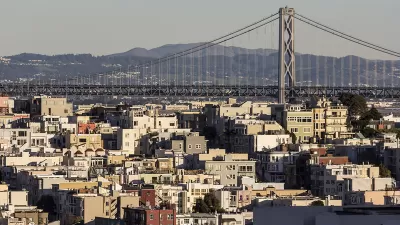A booming-once-again tech sector and a rapidly increasing population in the Bay Area are aggravating a historically tight housing market. Preservation architect Jerri Holan looks at how Bay Area cities are dealing with the housing crunch.
Last year, the Bay Area’s population increased by over 90,000 residents. The 2015 median price for an existing single-family detached house in the region was $1.25 million. It's not just San Francisco or San Jose, writes Bay Area preservation architect Holan. Other Bay Area cities are confronting the shortage of affordable housing in different ways, and confronting backlashes against increased density and new market housing:
Oakland – historically the affordable housing bastion in the Bay Area — has finally caught up with other cities and is experiencing a severe housing crunch. With an influx of residents priced out of San Francisco’s market, housing prices in Oakland are some of the highest in California. Many long-time residents are being displaced by newcomers. According to Arlene Baxter, a Bay Area residential Realtor, Oakland rents are rising even faster than home prices. Last week, the Oakland City Council passed an emergency 90-day moratorium on rent increases in order to study their crisis. Last month, the Council adopted new housing regulations to ease requirements for adding secondary dwelling units.
Other East Bay cities, too, are deregulating to increase density. Berkeley’s seven new multi-unit, high-rise projects have residents in an uproar about increased traffic and loss of bay views. Albany is adopting a new General Plan which significantly increases density around transportation modes. In Contra Costa County, Concord, planners, developers, residents, and city officials are arguing over the largest real estate project in Northern California: the development of the former Concord Naval Weapons Station, a mothballed Navy storage depot. A 2,200-acre community is planned with 12,000 new housing units that will reshape the entire region.
Holan continues,
In response, the Association of Bay Area Governments (ABAG) will issue its Plan Bay Area 2040 in June, 2017, encouraging a balance between jobs, housing and quality of life in the Bay Area. The need for direction as well as regional cooperation is critical if adequate transportation, open space, and historic resources are to be preserved. As expected, some cities want growth, others don’t. But desired or not, higher housing density is the future reality.
Another arrow in the arsenal of accommodating increasing growth is the increasing popularity and regulatory flexibility toward accessory dwelling units. Holan concludes that the housing crunch, and accompanying conflict to accommodate it won't go away soon. However, it will increasingly dominate the policies of local government as well as the skylines of Bay Area cities.
FULL STORY: Bay Area Housing – The Shape of Things to Come

Pennsylvania Mall Conversion Bill Passes House
If passed, the bill would promote the adaptive reuse of defunct commercial buildings.

World's Largest Wildlife Overpass In the Works in Los Angeles County
Caltrans will soon close half of the 101 Freeway in order to continue construction of the Wallis Annenberg Wildlife Crossing near Agoura Hills in Los Angeles County.

Coming Soon to Ohio: The Largest Agrivoltaic Farm in the US
The ambitious 6,000-acre project will combine an 800-watt solar farm with crop and livestock production.

California Grid Runs on 100% Renewable Energy for Over 9 Hours
The state’s energy grid was entirely powered by clean energy for some portion of the day on 37 out of the last 45 days.

New Forecasting Tool Aims to Reduce Heat-Related Deaths
Two federal agencies launched a new, easy-to-use, color-coded heat warning system that combines meteorological and medical risk factors.

AI Traffic Management Comes to Dallas-Fort Worth
Several Texas cities are using an AI-powered platform called NoTraffic to help manage traffic signals to increase safety and improve traffic flow.
City of Costa Mesa
Licking County
Barrett Planning Group LLC
HUD's Office of Policy Development and Research
Mpact Transit + Community
HUD's Office of Policy Development and Research
Tufts University, Department of Urban and Environmental Policy & Planning
City of Universal City TX
ULI Northwest Arkansas
Urban Design for Planners 1: Software Tools
This six-course series explores essential urban design concepts using open source software and equips planners with the tools they need to participate fully in the urban design process.
Planning for Universal Design
Learn the tools for implementing Universal Design in planning regulations.


























